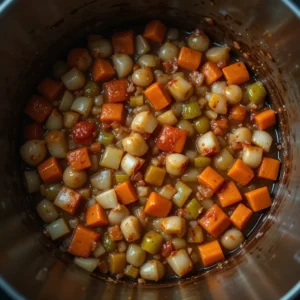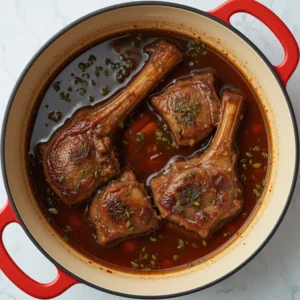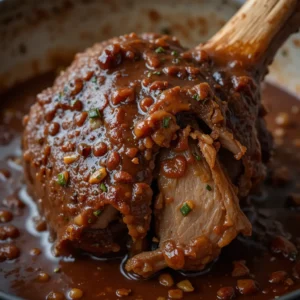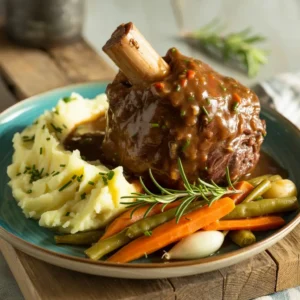Introduction:
When it comes to crafting a satisfying meal that’s both hearty and heartwarming, few dishes hit the mark quite like a beef shank recipe. To begin with, this often underappreciated cut of meat transforms magically when given time and patience. In fact, with just a few basic ingredients and a touch of culinary care, you can turn it into a tender, flavor-packed centerpiece perfect for any lunch gathering.
Moreover, this dish isn’t just delicious—it’s incredibly versatile. Whether you’re preparing a weekend family meal, hosting a cozy lunch with friends, or planning a make-ahead weekday treat, this beef shank recipe adapts beautifully to the occasion. Because of its bone-in richness and collagen-filled structure, beef shank lends itself best to slow cooking methods, allowing the flavors to deepen while the meat softens to melt-in-your-mouth perfection.
In other words, this recipe isn’t just food—it’s comfort, culture, and culinary satisfaction all wrapped into one steaming pot. Consequently, it appeals to food lovers across the globe, from rustic Italian kitchens to homey Southern tables and bustling Asian markets. So, if you’re ready to create a meal that speaks to both tradition and taste, keep reading. You’re in for a mouthwatering journey—one that begins with humble ingredients and ends in something extraordinary.
What Is Beef Shank Recipe?
Beef shank is a cut of meat that deserves more appreciation in modern kitchens. At its core, this flavorful portion comes from the leg of the cow, an area known for its dense muscle and high collagen content. Because cows use their legs frequently, the meat here is naturally tough. However, that very toughness transforms into exquisite tenderness when cooked the right way—especially using slow, moist-heat methods like braising or stewing.
Typically, a beef shank includes the bone (commonly called “bone-in shank”) and sometimes even the marrow, which seeps out into sauces and broths to add luxurious richness. You’ll often see this cut in traditional dishes around the world, including Italian osso buco, Vietnamese pho, and hearty beef stews from the American South. So, while it might not be the most glamorous-looking cut in the butcher’s case, it packs a punch in both flavor and nutrition.
Furthermore, beef shank is relatively budget-friendly, making it an excellent choice for families or home cooks looking to create something special without breaking the bank. Thanks to its connective tissue and sinew, it yields a deep, beefy flavor when slow-cooked—turning even the simplest ingredients into an indulgent experience.
In short, beef shank is a hidden gem in the culinary world. It’s tough yet tender, inexpensive yet luxurious, humble yet gourmet-all, depending on how you treat it in the kitchen. As a result, it’s no wonder global chefs and home cooks alike turn to beef shank when they want a dish that speaks volumes of tradition, depth, and satisfaction.
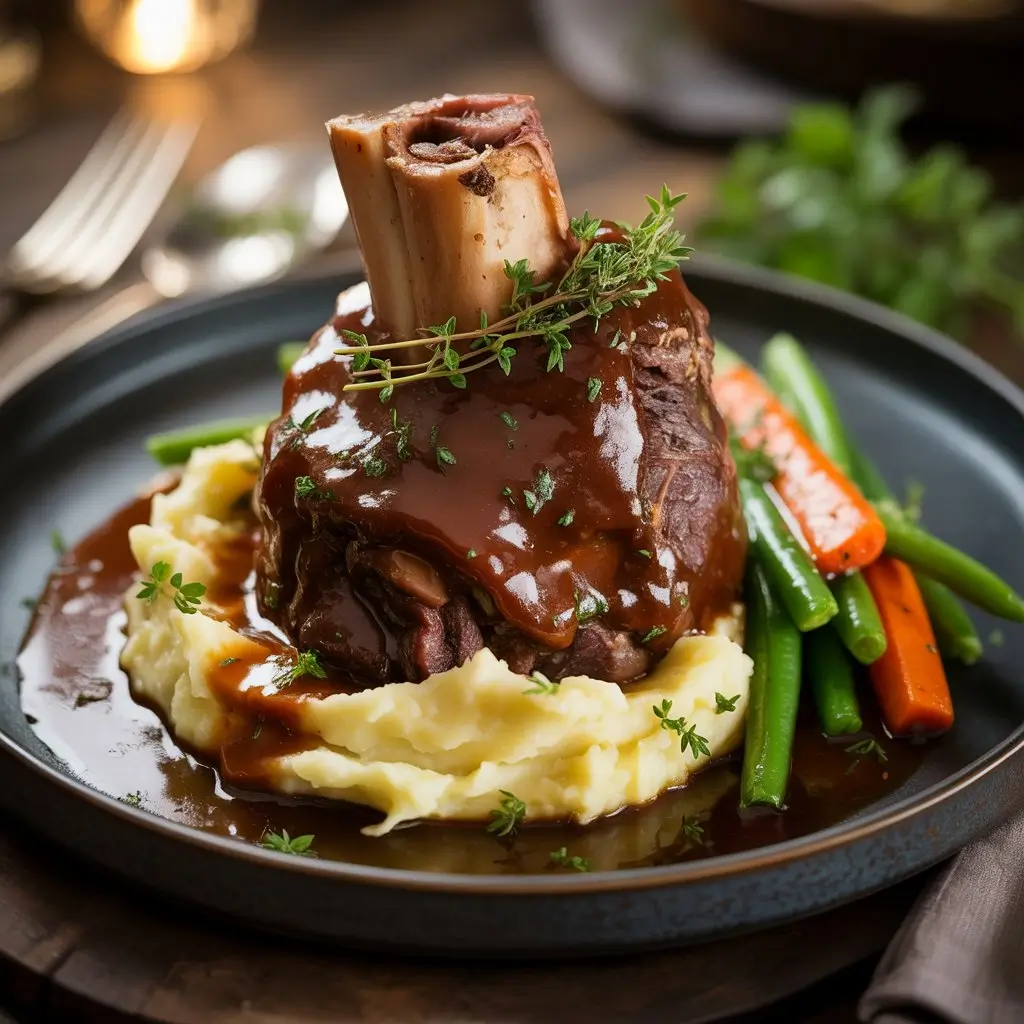
Why Choose Beef Shank Recipe?
Without a doubt, beef shank is one of the most underrated cuts in the world of cooking. While many people gravitate toward ribeye or sirloin for their obvious tenderness, those in the know understand that the real flavor lies in the less popular cuts—and the beef shank is a prime example. So, why should you choose it? Let’s break it down.
First and foremost, the beef shank is incredibly rich in collagen, which breaks down into gelatin during cooking. As a result, the final dish has a silky, luxurious texture that coats the palate in the most delightful way. Not only that, but this collagen also has potential health benefits for your joints, skin, and gut health—making this cut both delicious and nourishing.
Secondly, the bone-in nature of most beef shanks adds a deeper dimension of flavor. The marrow within the bone slowly seeps into your cooking liquid, enhancing sauces and stews with a savory richness that’s hard to replicate. Therefore, if you’re seeking depth and umami, beef shank will not disappoint.
In addition, it’s economical. Compared to prime cuts like filet mignon or ribeye, beef shank is often a fraction of the price. Consequently, it allows home cooks to craft gourmet-quality meals without overspending. And, because it’s such a tough cut initially, it forces you to cook low and slow—which, in turn, enhances the flavor even more.
What’s more, beef shank is also incredibly versatile. From comforting stews to sophisticated international dishes, it adapts to various cuisines and cooking styles. For instance, it’s perfect for Asian-style broths, European braises, or even Latin-inspired slow-cooked dishes.
Ingredients for Beef Shank Recipe
Before you begin, gathering all your ingredients will make the cooking process smoother and more enjoyable. Fortunately, this recipe uses simple, wholesome items that are easy to find in most grocery stores. Below, you’ll find the essentials, followed by optional add-ins to elevate the dish even further.
Main Ingredients:
| Ingredient | Amount | Purpose |
|---|---|---|
| Beef shanks (bone-in) | 2 pieces (about 1.5–2 lbs) | Main protein, full of collagen and marrow |
| Olive oil | 2 tablespoons | For searing and sautéing |
| Onion (chopped) | 1 medium | Adds sweetness and depth |
| Carrots (sliced) | 3 medium | Brings natural sweetness |
| Celery (diced) | 2 stalks | Balances flavor and adds aroma |
| Garlic (minced) | 4 cloves | Provides bold, savory undertones |
| Tomato paste | 2 tablespoons | Enhances richness and adds umami |
| Red wine (optional) | 1 cup | Adds complexity and acidity |
| Beef broth | 3 cups | Base liquid for slow cooking |
| Fresh thyme | 2 sprigs | Adds earthy, herbal notes |
| Bay leaves | 2 | Deepens the broth with subtle bitterness |
| Salt | To taste | Essential for seasoning |
| Fresh cracked pepper | To taste | Enhances overall flavor |
Optional Add-ins for Customization:
If you’d like to get creative, consider including any of the following ingredients. They can transform your beef shank recipe into something uniquely yours.
- Mushrooms (sliced) – Earthy depth and texture
- Potatoes (quartered) – Makes the dish heartier
- Rosemary or sage – Alternative aromatic herbs
- Worcestershire sauce – Boosts umami dramatically
- Lemon zest – Adds a bright, fresh note
- Chili flakes – For a spicy kick
- Parsnips or turnips – For a rustic, seasonal twist
Pro Tip: Always taste your broth before finishing the dish. Adjusting salt, acidity (via lemon or vinegar), or sweetness (via carrots or onions) can truly balance the flavor.
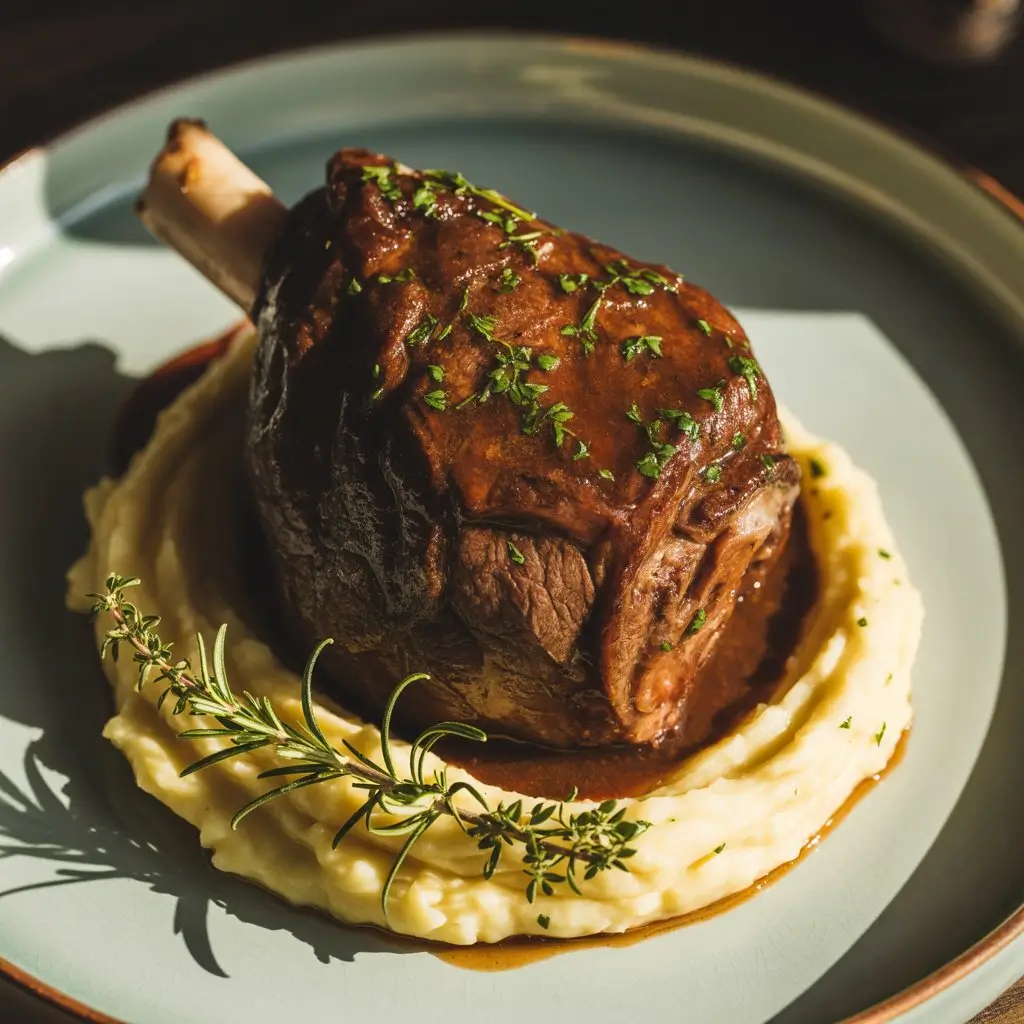
Step-by-Step Instructions for Cooking Beef Shank Recipe
Now that you’ve gathered your ingredients, it’s time to bring this hearty, flavorful dish to life. Follow these easy-to-execute steps and you’ll have a comforting lunch ready to impress even the most seasoned foodies.
Sear the Beef Shanks for Rich Flavor
To begin with, pat your beef shanks dry using paper towels. This is crucial because it allows for a better sear, which locks in juices and enhances the final flavor.
- Heat 2 tablespoons of olive oil in a large Dutch oven or heavy-bottomed pot over medium-high heat.
- Carefully place the beef shanks into the hot oil.
- Sear each side for about 4–5 minutes, or until a golden-brown crust forms.
- Once seared, remove them and set aside.
Build a Flavorful Aromatic Base
Next, reduce the heat to medium and add your chopped onions, celery, and carrots to the same pot. As they begin to soften, scrape up the flavorful brown bits left from the beef. This process, known as deglazing, builds the foundation of your sauce.
- Sauté for 7–8 minutes or until vegetables are tender.
- Add minced garlic and cook again for one minute.
- Stir in 2 tablespoons of tomato paste and let it caramelize for another 2–3 minutes, deepening the color and taste.
Deglaze with Wine for Complexity
After that, it’s time to add depth.
- Pour in 1 cup of red wine (optional but highly recommended) to deglaze the pot.
- Please leave it to simmer for 5 minutes or until it has been reduced by half.
- Stir often to avoid burning and even reduction.
Add Broth and Herbs, Then Return the Shanks
Once the wine is reduced, add in:
- 3 cups of beef broth
- 2 sprigs of thyme
- 2 bay leaves
- Salt and pepper to taste
Now, return the beef shanks to the pot. Make sure they are partially submerged in the liquid.
- Cover with a lid and bring the pot to a gentle simmer.
Slow-Cook to Tender Perfection
Then, reduce the heat to low (or transfer to a preheated 325°F oven).
- Let the beef shanks simmer for 2.5 to 3.5 hours, depending on thickness.
- Flip the shanks halfway through for even cooking.
You’ll know it’s done when the meat pulls away from the bone easily with a fork.
Rest Before Serving
Before serving, let the beef rest in the sauce for 15 minutes. This allows the flavors to meld and the meat to reabsorb some of the juices.
- Skim any excess fat off the top if desired.
- Taste and adjust seasoning.
Plate and Garnish
- Place each shank on a plate or shallow bowl.
- Spoon a generous amount of sauce and veggies over the top.
- Garnish with some parsley or thyme to add some color.
Serve with mashed potatoes, polenta, or crusty bread to soak up every last bit of that savory sauce.
And just like that, your slow-cooked beef shank is ready to serve. Whether it’s a lazy weekend lunch or a special occasion, this dish delivers flavor, comfort, and that wow factor every time.
Tips for a Perfect Beef Shank Recipe
Creating a restaurant-worthy beef shank recipe at home is absolutely possible—even for beginners. However, a few simple techniques can take your dish from good to unforgettable. With that in mind, here are some pro-level tips to elevate your cooking game.
Start with a Proper Sear
First of all, never skip the searing step. Searing locks in juices and builds a caramelized crust that adds a rich, umami base to your stew. Even though it might seem time-consuming, this step sets the tone for deep flavor throughout the dish.
Use Low and Slow Heat
Because beef shank is a tough cut, it requires long, gentle cooking to break down its connective tissues. Therefore, a Dutch oven on low heat or a slow cooker on the “low” setting for several hours is ideal. Rushing this step can result in chewy, unappetizing meat.
Let It Rest Before Serving
After cooking, let your beef shank rest in its own juices for at least 10–15 minutes. As a result, the flavors settle and the texture becomes even more tender. Consequently, your dish will taste more cohesive and flavorful.
Layer Your Seasonings
Moreover, seasoning should happen in layers, not just at the end. From the initial sear to the final simmer, taste and adjust salt, acidity, and herbs. In this way, every component contributes to a balanced, satisfying bite.
Don’t Forget the Broth Quality
In addition, always use a high-quality broth. Whether you go homemade or opt for store-bought, this liquid is the base of your flavor. For best results, choose low-sodium versions so you can better control the saltiness.
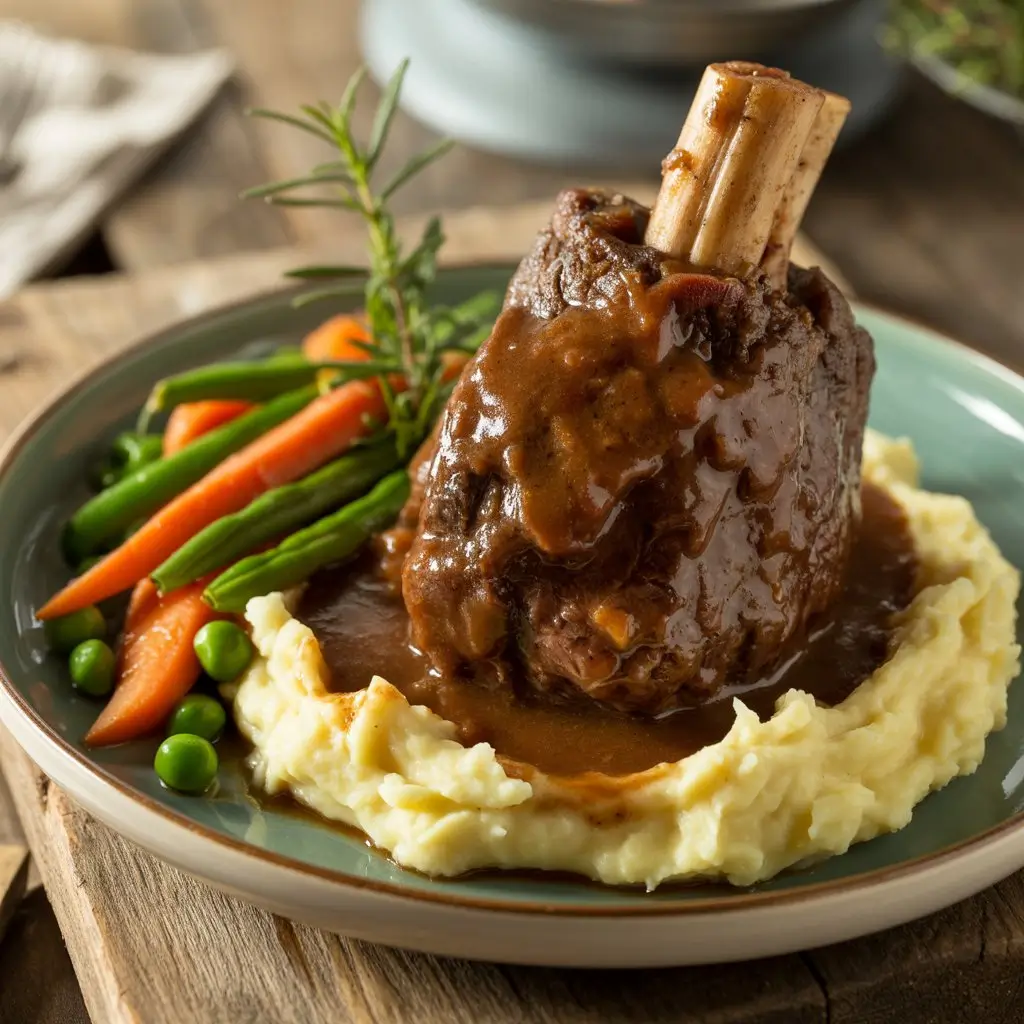
Variations on Beef Shank Recipes
One of the best things about beef shank is how versatile it is across global cuisines. With just a few tweaks, you can give your dish an entirely new flavor profile. Let’s explore some delicious variations.
Mediterranean-Style Beef Shank
To begin with, swap the wine for white wine or lemon juice, and add ingredients like:
- Kalamata olives
- Cherry tomatoes
- Fresh oregano
- Garlic and rosemary
- Artichoke hearts
As a result, you’ll have a dish that’s bright, aromatic, and perfect with couscous or roasted potatoes.
Asian-Inspired Braised Beef Shank
Alternatively, give your dish a bold, umami twist by going East. Use:
- Soy sauce in place of salt
- Fresh ginger and scallions
- Star anise and cloves
- Chinese cooking wine or rice vinegar
- Bok choy or daikon radish as add-ins
Because of these ingredients, your beef shank will resemble flavors from Taiwanese or Chinese braised dishes—great over jasmine rice or noodles.
Spicy Mexican Beef Shank
Looking for heat? Turn your dish into a zesty, south-of-the-border experience:
- Add chipotle peppers in adobo
- Use cumin, smoked paprika, and oregano
- Swap wine for Mexican beer
- Throw in black beans or hominy
Consequently, you’ll have a spicy, comforting stew that pairs well with warm tortillas or cornbread.
Rustic French Osso Buco-Inspired Beef Shank
If you’re feeling fancy, go French with:
- A splash of white wine
- Mirepoix (onion, carrot, celery)
- A bouquet garni (bay leaf, thyme, parsley stems)
- A gremolata topping (lemon zest, garlic, and parsley)
Although traditionally made with veal, beef shank holds its own in this elevated dish—best served with polenta or creamy mashed potatoes.
Plant-Based “Beefy” Shank-Inspired Stew
Surprisingly, you can mimic this dish’s texture and depth using plant-based alternatives:
- Use jackfruit or mushrooms as your “meat”
- Vegetable broth instead of beef stock
- Add soy sauce, nutritional yeast, and smoked paprika for richness
- Include root vegetables like turnips or sweet potatoes
In doing so, you’ll offer vegetarians and vegans a satisfying, earthy, and flavorful alternative.
In conclusion, beef shank is one of those rare cuts that adapts to nearly any culinary tradition. So whether you go classic or creative, you’ll always end up with something hearty, flavorful, and worth every bite.
Serving Suggestions for Beef Shank
After hours of slow-cooking, your beef shank is fall-apart tender and swimming in a pool of deeply flavorful sauce. Now comes the fun part—deciding how to serve it. Whether you’re aiming for rustic comfort or elegant presentation, these serving suggestions will help complete the meal beautifully.
Mashed Potatoes: A Classic Companion
First and foremost, you can never go wrong with a generous scoop of buttery mashed potatoes. Because of their creamy texture, they complement the rich, gelatinous sauce of the beef shank perfectly. Moreover, the potatoes act like a sponge, soaking up every drop of the flavorful broth.
Pro Tip: For added depth, infuse your mashed potatoes with roasted garlic or a splash of heavy cream.
Polenta or Creamy Grits: A Southern Touch
Alternatively, swap the mash for a bowl of creamy polenta or grits. These options, although slightly less common, add a Southern twist and an ultra-smooth base to contrast the tender, chunky beef.
In addition, adding cheese, like Parmesan or aged cheddar, can transform your polenta from simple to sensational.
Rustic Bread: For Sopping Up Every Drop
If you’re keeping it casual, serve the beef shank with thick slices of rustic bread. Not only does it add texture, but it also lets diners enjoy the broth down to the very last spoonful. Furthermore, this option is ideal for lunch settings or communal dining experiences.
A crusty sourdough or herbed focaccia works wonders here.
Steamed Rice or Herbed Couscous
For those who prefer lighter grains, herbed couscous or jasmine rice are excellent choices. In particular, these sides work well when you’re leaning toward a Mediterranean or Asian variation of the dish. Because they are quick to prepare, they’re perfect for busy weekday lunches.
Even better, they make fantastic leftovers when soaked with the leftover sauce.
Roasted or Steamed Vegetables
In case you’re seeking balance, don’t forget the veggies. Roasted carrots, steamed green beans, or grilled asparagus can add freshness and color to your plate. What’s more, they provide a nutritious element to an otherwise protein-heavy meal.
Therefore, including vegetables is both a flavor enhancer and a health-conscious move.
Side Salad with a Zesty Vinaigrette
On the other hand, if you want to lighten things up, pair the richness of beef shank with a crisp side salad. A simple vinaigrette made with lemon juice, olive oil, and Dijon mustard cuts through the richness and refreshes the palate.
As a result, your meal feels complete without being too heavy.
Wine Pairing Ideas
To truly elevate the experience, consider pairing your beef shank with a bold red wine. Think Cabernet Sauvignon, Malbec, or Syrah—each capable of standing up to the dish’s robust flavor. Alternatively, a full-bodied red blend works beautifully, too.
Note: If you used wine in the cooking process, try serving the same varietal alongside the meal for a harmonious pairing.
In summary, beef shank is a canvas for creativity when it comes to sides. From buttery potatoes to vibrant vegetables, the right pairing can elevate your dish from satisfying to sublime. So, go ahead—experiment, taste, and find your perfect match.
Conclusion:
In the end, few dishes deliver the same level of comfort, flavor, and satisfaction as a well-made beef shank recipe. From the moment you sear the meat to the final simmer in rich, aromatic broth, this dish proves that patience in the kitchen always pays off. Not only is it packed with robust, fall-off-the-bone goodness, but it also adapts effortlessly to different culinary styles—from Mediterranean zest to Asian-inspired depth.
Moreover, this recipe is as practical as it is delicious. Whether you’re cooking for a crowd or prepping ahead for the week, beef shank offers an affordable, flavorful solution that brings restaurant-quality results straight to your table. As a result, you not only serve a nourishing, wholesome meal—you create an experience your family or guests will remember.
So, now that you have everything you need—from ingredients and variations to tips and plating ideas—it’s your turn to make magic happen. Why not try it this weekend? Light a candle, serve with your favorite side, and let the slow-cooked aroma turn your kitchen into the coziest corner of the world.
Finally, don’t forget to share your culinary creation with others. Drop a comment below, tag us in your food photos, or pass this recipe along to a fellow food lover. After all, great food becomes even better when it’s shared.
FAQs
Slow cook for 2.5 to 4 hours, depending on your method. The meat should be fork-tender.
Absolutely. 45–60 minutes on high pressure is ideal.
Carrots, potatoes, celery, onions, and mushrooms enhance the dish naturally.
Yes, try oxtail or short ribs—but expect slight texture differences.
When the meat easily pulls apart with a fork, it’s ready.
Yes, and it’s recommended! The bone marrow adds unmatched depth.
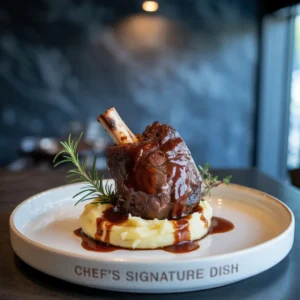
Melt-in-Your-Mouth Braised Beef Shank Recipe: A Hearty One-Pot Comfort Classic
Equipment
- Dutch oven or heavy-bottomed pot
- Wooden spoon
- Tongs
- Sharp Knife & Cutting Board
- Measuring cups & spoons
- Ladle
- Optional: Slow cooker or oven (if not using stovetop)
Ingredients
- 2 bone-in beef shanks (1.5–2 lbs total)
- 2 tbsp olive oil
- 1 chopped onion
- 3 sliced carrots
- 2 diced celery stalks
- 4 minced garlic cloves
- 2 tbsp tomato paste
- 1 cup red wine (optional)
- 3 cups beef broth
- 2 sprigs fresh thyme
- 2 bay leaves
- Salt and black pepper to taste
Instructions
- Sear the Meat: Pat dry and sear beef shanks in oil until browned; remove and set aside.

- Sauté Vegetables: Cook onion, carrots, and celery in the same pot; add garlic, tomato paste, and cook until fragrant.

- Deglaze: Pour in red wine and reduce by half.

- Add Liquid & Herbs: Add broth, thyme, bay leaves, salt, and pepper. Return beef to pot.

- Simmer Slowly: Cover and simmer on low for 2.5–3.5 hours (or oven at 325°F).

- Serve: Plate with sauce and veggies; pair with bread, mashed potatoes, or polenta.



